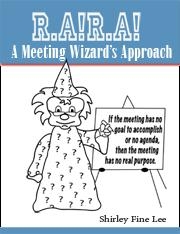|
This bimonthly
e-news is made available
to further the mission:
�
�To
help organizations increase employee and system potential to produce
results.�
�
We encourage sending this to others so they may benefit from the information
provided.�
�
If you know others who would like to subscribe to this newsletter, please
forward this issue so they may
click here to subscribe.
�
To
remove your name from e-mail list,
click here to unsubscribe.
�
To
review past newsletters,
click here for archives. � If you would like to reprint
an article or have a similar article written for your newsletter, please contact
the newsletter editor.
�
Providing:
Classroom Delivery,�
Communication Publishing,
Consulting Services,
Instructional Design,
Keynote Addresses,
Meeting Facilitation,
Newsletter Articles,
Productivity Training,
Seminar Speaking,
System Support,
and Team Building.
�

�
Copyright 2007
�Shirley Lee
All Rights Reserved
www.ShirleyFineLee.com |
�
According to executives at
Fortune 500 companies less than 50% of their change initiatives were
successful.
�
�
When planning a change
initiative, you should ask the following questions.
��������
Who will take what
roles in the change process and what will be their responsibilities?
��������
What will the new
structure or process look like after the change?
��������
Who will this change
affect and how does this change affect those people?
��������
What are the
different stages of the change plan and what are the desired deadline dates?
��������
What type of
communications should be provided, to whom and when or how often?
�
If you are looking for
a good book on the change process or the people side of change, consider:
���������
"Managing At the
Speed of Change" by Daryl R. Conner
���������
"Managing
Transitions: Making the Most of Change" by
William Bridges
�
�
How can your computer help with
change initiatives?� You probably already know how you can use it to create
both text and graphic communications to reinforce the change plan.� And some
of you may use spreadsheets, project management software, or other
applications to track progress on schedule and budget.� These methods help
you once you have decided how to deploy your change.� What if you haven�t
decided on what the best change to make is or need help on coming up with a
process for the change deployment?� To help you get a jump on planning your
change in the best way, you can utilize search engines to find change
management books, consulting, training, and other tools.
�
�
I�d like to
share an idea I use in workshops and meetings for helping managers and teams
to understand the importance of proper planning when managing a change
plan.� In your next facilitated meeting or training session, try the
activity I designed and outlined in the Dallas ASTD newsletter article at
http://www.dallasastd.org/news/ASTD/articles/Black_hole.htm
�
�
"The
art of progress is to preserve order amid change and to preserve change amid
order."
- Alfred North Whitehead
|
ISBN:
1-4196-5367-9
ORDER BOOK AT
www.Amazon.com
�

�
R.A!R.A! A Meeting Wizard's Approach
IN THE NEWS
�
KEYNOTE
SPEAKER
AVAILABLE!
�

�
Where�can the Meeting Wizard be heard?
The Meeting Wizard's
calendar has openings.��
Contact Shirley Lee at
214-457-5736
Keynote Topics on Web
|